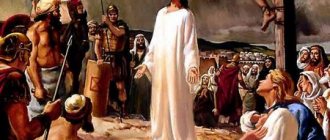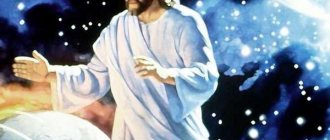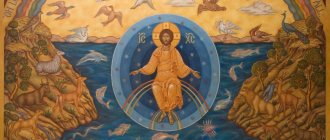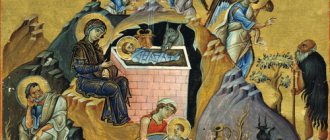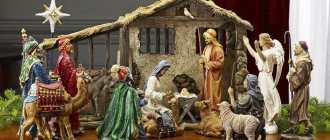Basic teachings of Jesus Christ
| Believe in the Heavenly Father. | Throughout his entire earthly life, He never once called himself God, but only the son of God and man. |
| He inherited to Humanity a single prayer: “Our Father.” | Our Father who art in heaven! Hallowed be Thy name; Thy kingdom come; Thy will be done on earth as it is in heaven; Give us this day our daily bread; and forgive us our debts, as we forgive our debtors; and lead us not into temptation, but deliver us from evil. For Yours is the kingdom and the power and the glory forever. Amen. It contains the whole essence of His teaching, which is completely different from what other religions preach (they are much more complex, both before and now). |
| Communicate with the inner God, the Father. | Other religions have an external idol for worship. All the instructions of Jesus Christ teach us this communication. It is important to prepare your body and soul for his arrival. |
| "Commandments of Love": |
|
| "The Beatitudes": |
|
| Other commandments: |
|
| He taught about the conditions for entry into the Kingdom of Heaven. | The basis of Salvation is sincere faith in Jesus Christ and righteous Christian life. |
The Lord's teaching was supra-religious. He never argued about faith with others or about the existence of the Gods they worshiped.
The Torn Out Years of Jesus
Author: Ilya Nosyrev
Where was Christ between birth and crucifixion? Why doesn't the Bible tell where the Son of Man spent most of his life?
The greatest of the world's religious teachers left an unprecedented mark on history: in his name wars were declared and peace was concluded, for his sake people went into the flames of the fire and to the scaffold, renounced their beloved women, preferring to them a secluded cell in the desert. Isn't it strange that we know so little about his life? The Gospels tell mainly about his birth and the four years that preceded his death. But what did Jesus do between approximately fourteen and thirty years of age? Where did he get the ideas that led him to worldwide fame, who did he study with, where did he hone his gift as a preacher? Maybe these were the “snatched years,” as they say in Odessa about difficult years that are better forgotten?
Light from the East
“A simple Soviet boy, the son of a carpenter and joiner”... It’s as if these words were written about Christ. It seems surprising that this man, who most likely was a carpenter by profession (in ancient Jewish society, a son inherited his father’s craft), could himself create a teaching that conquered half the world. Of course, Christ’s sermons did not grow out of nowhere - seven hundred years before his birth, Isaiah said much of what he said. In the speeches of Jesus one can also hear an echo of texts created by the Essenes - Jewish sectarians who lived in the desert in anticipation of the apocalyptic battle between Light and Darkness. And yet, the teaching of Christ is very different from everything that has already been heard in the Promised Land. If we look for its roots, it will probably be somewhere in other countries.
The Bible even speaks sparingly about the childhood of the Savior. Was the wonderful youth really planing boards with a plane? In the apocrypha, created a hundred years after the crucifixion of Jesus, called “The Gospel of Childhood,” the early years of the Son of Man are described in more detail, but somehow strangely: they say that at the age of five Jesus played at the ford, collecting water in puddles and sculpting sparrows from clay. It was Saturday, a day on which the Torah forbids, among many other things, the creation of images. The neighbors immediately complained to Jesus' father Joseph, who ran to the river and began to scold his son. Then Jesus said to the sparrows: “Fly!” - and they flew into the air. It was then that the neighbors realized that they had not messed with an ordinary boy, and they were even more frightened when another child, out of hooligan motives, spilled the water that Jesus was collecting in puddles, and he cursed him for this so that the poor fellow dried up on the spot. And he said to another boy who pushed him: “You won’t go anywhere further,” and he fell and died.
Wait, are we talking about the same person? This is not Christ, but, God forgive me, Damien from “Omen”! True, he later resurrected all the victims - and yet a residue remained: it is impossible to believe that this is really the Jesus we are accustomed to imagine. In addition, this apocryphal gospel is overloaded with miracles, and actually about the life of “a curly-haired Jewish baby, who - later - was brought to Golgotha by his quarrelsome and restless character” (we thank Anatoly Mariengof for this description), there is almost nothing to learn from there.
"Holy Family" Indian miniature. 17th century
Even in the Middle Ages, thinkers puzzled over this amazing silence of the Bible about the “snatched years” of Christ.
It seemed logical to explain that at that time he was living somewhere outside of Judea. Maybe in Egypt, where his parents took him? However, when Europeans became acquainted with Indian culture, a different version appeared: it was difficult not to notice that the life of Christ is surprisingly similar to the biography of another Hindu god, Krishna. So similar that it seems as if we are talking about the same person: both Krishna’s mother is the immaculate Devaki (without losing her purity, she gave birth to eight more brothers for Krishna, but let’s attribute this episode to the poverty of imagination of Bollywood scriptwriters), and Krishna’s uncle, who was predicted that his nephew would deprive him of the throne, organized a massacre of infants in the kingdom, and Krishna himself drove out the demons, and raised the dead, and he died nailed by an arrow to a tree. I washed my students’ feet too! Isn't it a striking resemblance? The same amazing coincidences were found between the lives of Christ and Buddha. And their moralistic teachings looked like twins. Didn’t the Savior study somewhere in India? This would explain everything at once: it was there that he could glean most of his humanistic ideas. But this was only a hypothesis - without facts it was worth no more than the story of Christ’s visit to Britain, which is found in the legends of the Knights of the Round Table.
“Most Hindus have no problem regarding Christ as a god: they are ready to accept him as another avatar of Vishnu.”
However, in 1887, this version received the most thorough confirmation. A book was published in Paris by the Russian traveler Notovich, who allegedly discovered manuscripts in Tibet indicating that Christ visited here. Moreover, the manuscripts stated, he even lived here most of his life.
Rehearsal of the crucifixion
Nikolai Notovich is a bright personality: long before Alexander Rosenbaum, he managed to combine the incompatible in himself - he was a Jewish Cossack. In his youth he was baptized into Orthodoxy, and later served in the cavalry, gaining fame as a grunt and even an aristocrat. After his resignation, he became one of the pioneers of what we would call socio-political journalism - he published the newspapers “Financial Review”, “Evening Courier” and “Golos”. He wrote a series of patriotic books on foreign policy issues. He traveled a lot in the countries of the East, in particular, he tried to scout out a safe land route to India, which would help Russia win the fight with England for control of Central Asia.
Chinese scroll
Notovich was no more interested in Christ than in France’s position on the Ottoman issue; he made his discovery by accident. After the Russian-Turkish War in 1878, he went to India - and got all the way to Ladakh, to the very foot of the Himalayas. In one of the Buddhist monasteries, Notovich got into a conversation with the abbot about Christianity - and suddenly learned that the name of Christ is known here not only thanks to missionaries from Europe. The monasteries of Tibet contain ancient records relating to the life of “Saint Issa, the best of the sons of men.” It turns out that Christ personally visited these places, and not just as a tourist: here he became acquainted with local religions and preached himself. What he heard made his head spin: Notovich decided to see these scrolls at any cost. He was drawn to this mountainous country by legends about its monasteries, which kept their secrets in the shadows of silent masses, among snow and ice, under an eternally gray sky like lead. Was it not the same curiosity that forced Jesus to leave his homeland?
…By the time Jesus turned thirteen—the legal age to seek a wife—he was known as the first student of the religious school and a brilliant preacher. The house of his parents, who lived by modest labor, began to be visited by rich people who wanted to see him as their son-in-law. However, instead of pleasing his father and mother with a marriage to a prominent bride, Jesus decided to see the world: he headed to the Indus. As the gospel found by Notovich stated, “he wanted to study the laws of the great Buddhas” - Indian ascetics who achieved enlightenment.
“Some Buddhist thinkers believe that on the cross Jesus achieved complete renunciation and went straight to nirvana.”
How could a Jewish youth know about some Buddhas? Wasn't the ancient world tens of times larger than ours? Now you can board a plane and fly from Moscow to Tibet in a few hours. And why fly if you can read the latest sermon of the Dalai Lama on the Internet? However, they heard about Buddhism in Judea: hundreds of years ago, preachers arrived here from India and debated with Hellenic philosophers. The cultural ties between East and West in ancient times were sometimes so strong that it is sometimes difficult to draw the line between one religion and another. Let us give just one example: on December 2, the Orthodox Church honors the memory of Saint Josaphat (Josaphat), an Indian prince, whose righteous life is told by John of Damascus. But few people know that Jehoshaphat is a distorted “bodhisattva,” and the life of the prince conveys in detail the biography of the Buddha, stories about whom in ancient times came to the Middle East. This is how the Perfect One acquired the title of saint in Orthodoxy.
"Hosanna". Laura James. 1995
A year after Jesus left Judea, he forded the Indus and settled among the “Aryans.” The rumor about the talented teenager spread throughout the surrounding villages, and the Jains, Indian ascetics, wanted to have him as their student. True, Jesus flatly refused to study with them: they demanded too monstrous forms of renunciation from the world. Instead of shaving their heads, they preferred to pull out hair by hair in order to learn to despise pain. They walked naked and did not eat for days, refusing even to beg. Suicide was considered a good way to end one’s life: the soldiers of Alexander the Great were once delighted by the fearlessness of the Jain Kalan, who voluntarily climbed onto the fire to rid the soul of its decaying shell. But their asceticism seemed senseless to Christ, and he set off to wander through Indian cities.
After what he saw here, social inequality in Judea should have seemed like a light version to him: in his homeland, the rich talked to the poor through clenched teeth, but here people from different castes sometimes could not even look at each other. And even the very last Shudra servant had those whom he himself could despise - the “untouchables” who were engaged in burying dead bodies and cleaning latrines. The Brahmin priests and Kshatriya warriors were offended by his democracy: the boy shunned the society of the nobles, preferring to associate with the lower classes - with Vaishya traders and Shudras, considering them equal to himself. “Only death will free them from slavery,” the Brahmins admonished him. God the Father, Jesus said, makes no distinction between His children: “On the day of the final judgment, the Shudras and Vaishyas will be forgiven much for their ignorance; on the contrary, the wrath of God will punish those who have arrogated His rights to themselves.”
“The most ardent Christians in Africa are Copts, descendants of the ancient Egyptians: on some frescoes, Jesus looks like Osiris giving eternal life”
And Jesus did not believe in their gods: he said that God had no need to play with toys, incarnating himself in all sorts of Vishnu and Shiva. He created the world alone and did not share his power with any living creature. At times, the priests whom he criticized directly begged him: perform a miracle - and we will believe you. At least destroy the stone idols for whose worship you blame us. Christ responded with a proposal to the proposal: no, if they are really powerful, let them strike me down on the spot. The priests left unsalted and, like their colleagues later in Judea, began to look for an opportunity to capture Jesus, but he, warned by the poor of the danger, left this land and went to Nepal, where Buddha was once born.
On a slippery slope
Unlike the canonical Gospels, there are no miracles in the Tibetan treatise published by Notovich: Jesus does not raise the dead or cast out demons. This gives the text a spirit of realism: you read and seem to see everything with your own eyes. So Jesus sits down between his disciples, as black as a tree, tries for a while to assume the lotus position, and then waves his hand: down with show, because the Spirit gives life, and the flesh is of no use. His sermons are passionate and understandable to these half-beggars, dressed in simple pieces of cloth: “A man humiliates the working people by the sweat of his brow, currying favor with the idler sitting at a magnificent table.” How familiar this is even now, two millennia later!
“Christ died not to save people, but to teach them to save each other”
Oscar Wilde
...For Russian people at that time, few places on earth were as inaccessible as Tibet, and yet Notovich decided. I took a train to Rawalpindi and, accompanied by a servant, the black Philip, and several Indian guides, began climbing the mountains. What motivated him? Hardly the usual journalistic curiosity. Probably, a man who tried on so many masks - a Cossack, a patriot, a brave journalist - felt that he had touched something truly real. And if Christ himself wanted to become something more than an experienced carpenter, then Notovich wanted to go down in history as more than just a fearless cavalryman. There was another reason, but we will save it until the end of the story.
"Holy Family" (fragment). Japanese school. 20th century
In the mountain village of Notovich, for a lot of money, he bought a local tarantass - like a round table on wheels, on which one could travel with some convenience: however, due to the lack of a backrest, the rider every now and then risked sliding off the “table top” straight into the abyss. The prudent British built a network of small hotels along the roads, the comfort in which, however, was very relative - Notovich sat awake all night long, as scorpions and centipedes ran rustling along the clay walls. The nature of this country seemed to take revenge on him for his desire to penetrate its heart and steal its great secret. Rocking on his tarantass, under the scorching sun, brushing aside the midges, he closed his eyes - and he imagined Jesus wandering along narrow paths among the mountains, to the cells where, like termites, monks nested, monotonously muttering their incomprehensible words. The future Messiah spent six years in Buddhist monasteries, studying the sacred sutras, mastering the Pali language perfectly, and then descended to the Rajputana valley and began to teach people again. He hardly left the monks without conflict: in his sermons he denied the key principle of reincarnation for all Indian religions. “He will never humiliate His child by forcing his soul to move, as in purgatory, into the body of an animal,” he said about God. A new reality was opening up before the amazed Hindus: the slumbering world would soon be awakened by heavenly thunder, the mountains would collapse into the abyss and there would be nowhere to hide from the sight of the Lord. Huge India, tossing and turning, woke up, and Christ, feeling that here he had already learned everything he wanted and did everything he could, decided to return to his homeland.
...After a short rest in Kashmir, Notovich’s expedition moved further into the mountains. As people walked in the dark along a narrow path between old fir and birch trees, the silence of the forest was broken by a terrible howl. A torch flashed in the darkness, and Notovich saw the eyes of a panther, which was gnawing on the body of one of the servants. Notovich raised his hard drive. The beast growled, about to jump on him, but suddenly changed its mind and dived into the thicket.
"Christ leaves his mother." Albrecht Altdorfer. 1520
If Notovich were inclined towards mysticism, he would see a symbol in this bloodthirsty beast: after all, this is the name - Panther - given by the malicious author of the Talmudic commentary to the Syrian soldier who was supposedly the father of Jesus. They also tried to feed Christ to wild animals: when he came to Persia, the priests did not like his preaching. Jesus did not order the inhabitants to worship the sun and fire: to speak with the Lord, no intermediaries are needed, he assured. The elders were afraid to arrest him in front of the people, however, when night fell, they grabbed him and pushed him out of the gate - they hoped that he would become an easy prey for tigers and jackals. However, Christ did not die - he reached Judea on foot and began to preach in his homeland.
The canonical Gospels are silent about the content of the speeches that he delivered at this time, but the Tibetan treatises are striking: it turns out that he convinced his compatriots to respect women - the years spent in Buddhist communities, where the daughters of Eve could occupy an important position, were not in vain. “Honor the woman, for she is the mother of the universe, and all the truth of divine creation is contained in her,” said Jesus. - Her love ennobles a man, softens his hard heart, tames the beast and makes him a lamb. Do not humiliate her, by doing this you will only humiliate yourself and lose that feeling of love, without which nothing exists here below. Whatever you do for your wife, your mother, a widow or any other grieving woman, you will do for God.” Where did all these thoughts go in medieval European Christianity, where a woman was called nothing more than a “vessel of evil”? God knows.
Jesus Was Here
"Mary and Jesus". Laura James. 1991
Here they are finally - the legendary monasteries of Tibet. Notovich was slightly disappointed: the monks turned out to be simple people, without a shadow of any mystery. The lama, whom the travelers visited first, treated the guests to local beer - chang, the frequent use of which made a person obese, which was considered a sign of heaven's favor. He complained about Muslims who forcibly converted his flock to their faith, and said that Buddhism has and cannot have anything in common with Islam. Christianity is another matter: after all, it is just a variety of Buddhism. When Notovich began to argue, the lama told him the story of Jesus: “Issa is a great prophet, one of the first after the twenty-two Buddhas. He is greater than any of all the Dalai Lamas. It was he who enlightened you and returned the souls of the lost to the fold of religion.” It turned out that Jesus merely brought the teachings of Buddha to the European peoples, which they were not slow to distort. It was for this task that he was born again to a woman from Galilee. To prove that he was right, the lama mentioned ancient scrolls, copies of which are kept in many monasteries in Tibet. True, he himself does not have a single copy, but every child here knows about them.
Notovich was determined to see these treatises with his own eyes, even if for this he would have to visit every monastery in Tibet. For this, he had to cross several high mountain passes and visit ten more monasteries. In each, the same story was repeated - they knew about “Issa” here, too, but they could not show any evidence of his presence in India. Desperate, Notovich stopped to rest near the large Hemis monastery in Ladakh. Here they were preparing for the holiday, and the traveler decided to attend a costume performance - to the mournful sounds of trumpets, twenty people dressed as devils and monsters fought with the “gods” in white and gold robes. Tired of the performance to the point of ripples in his eyes, Notovich went out onto the terrace and sat down opposite Lama Hemis, whose eyes shone with intelligence and kindness.
“Spas” (fragment of a triptych). N. Goncharov. 1910-1911
How strange, the traveler told him, Buddhism strives to get rid of the external, but here there are so many colors and colors... This is exactly what these ideas are for, the lama explained. A person is always looking for something that is accessible to his senses. The Egyptians idolized animals, trees and stones, the Assyrians deified the stars, but only a select few managed to free themselves from the bonds of images that connect us with reality. Notovich skillfully directed the conversation to the chosen one he needed. “The name of Issa is highly respected by Buddhists,” replied the lama. - But people mostly don’t know about its very existence. Only the high lamas who studied the documents about his life know something about him.” And then he said what Notovich had been wanting to hear for many weeks: in his monastery there are copies of scrolls written about the life of Jesus.
The abbot did not want to continue the conversation. He apologized, saying that it was time for him to return to his rituals. Relations between Russia and England were tense, and Notovich was also known to the British colonial administration as a man who compiled a detailed map of Indian roads and rivers. Realizing that if he began to show interest in the monastery library, he would immediately be expelled from the country as a spy, Notovich reluctantly decided to leave empty-handed. And then chance helped him. Moreover, it was an accident: having rode very close to the monastery, he fell off his horse and broke his leg. It’s hard to believe that this was just a coincidence, and he was an excellent rider - probably the traveler already realized that spiritual knowledge cannot be obtained without damage to mortal flesh. Be that as it may, the compassionate monks could not leave him in trouble and provided first aid. In the few days during which he stayed at the monastery, Notovich managed to convince them that his interest was purely scientific in nature. Yielding to his requests, the lama brought two large bound volumes with pages yellowed with age and began to read Issa’s biography in Tibetan. Notovich wrote down the translation in a notebook, which was done by an interpreter present at the scene. The records about the life of Jesus were scattered: the traveler himself built them into something like a plot. How many secrets he learned! Even the end of Jesus' earthly life was depicted differently in the Tibetan Gospel. It turns out that it was not the Jewish priests, but the ruthless functionary Pilate who wanted his death - Caiaphas, who sympathized with the ideas of Christ, could only wash his hands, the Tibetan text assured.
"The Blessed Virgin Mary and Child." 17th century
When Notovich, having arrived in Europe, showed his French translation of the text to the famous author of “The Life of Jesus” Ernest Renan, his eyes lit up: give me your manuscripts, I will make a report on them! But the traveler was afraid that the old man would take all the glory of the discoverer for himself, and published them himself. Everyone to whom he told about this idea recoiled from him like a leper: the Monk Plato, Metropolitan of Kiev, and one of the cardinals of the Roman Church warned him about the undesirability of the publication, and one of the cardinals of the Roman Church, who said that he was leading those of little faith into temptation. When a book called “The Unknown Years of Jesus” was published in Paris, it had the effect of a bomb exploding. They started talking about Notovich. True, instead of the honors due to discoverers, the glory of a forger awaited him! The leading Indologist of the time, Max Müller, ridiculed his gullibility, suggesting that cunning Tibetan lamas had taken advantage of the "great white lady's" interest in exotic secrets. Less scrupulous critics accused Notovich of not having been to any Tibet - some lady traveler sent a letter directly from there that she had not seen him there.
Notovich tried to defend himself, but he had no authority in historical circles - some kind of Cossack, a paper maker and, according to rumors, also a spy! The Pope included his work in the “Index of Forbidden Books,” and historians years later cited this work as an example of a mediocre forgery of ancient texts. True, in certain circles his book gained real popularity. She was raised on a shield by Blavatsky’s disciples, who were equally happy to talk about Christ in India and about the Martians. Notovich himself was not happy about the privatization of his ideas by the mystics, but he could not do anything: in 1908, there was even a sequel to his book called “The Gospel of the Age of Aquarius,” written by the American preacher Levi Dowling. The author confirmed: yes, Christ was in India - he received reliable information about this... during a spiritualistic seance. Notovich no longer found out that in 1925 the correctness of his words was confirmed by Nicholas Roerich, who reached Hemis and heard the legend about “Issa” from the monks. True, Roerich himself was a mystic and did not disdain the same spiritualistic seances. And only a hundred years later historians began to agree that the “Tibetan Gospel” is an authentic text. But more on that later.
It didn't end with a cross
"Nativity". Hans Leonard Schaufelein. Early 16th century
This would be the end of the tale, but, as it turned out, Notovich was not the only one who was looking for materials about the unknown years of Christ: a publicist appeared in the Muslim East claiming that Christ visited India twice - the first time before the crucifixion, and the second... after. The fact that he did not die on the cross was not news for Muslims: after all, the Koran says that instead of Christ, God gave a ghost to be crucified, and saved Jesus himself from execution, which was considered shameful among the Romans, by taking him alive to heaven. However, the Indian Muslim Mirza Ghulam Ahmad, who wrote the treatise “Jesus in India” in 1899, denied this miraculous end and argued that the life of an ordinary person awaited Jesus: together with his mother, Mary Magdalene and several disciples, he went to Asia and lived there to old age. years old, and was buried in Kashgar. Where his grave still exists to this day.
Here is how it was. On the day when Jesus was crucified, Judea was shaken by an underground shock - the Bible also mentions this. The earthquake caused general confusion - onlookers watching the execution ran to check their houses: whether the roof had collapsed, whether thieves had climbed through the cracked walls... In this confusion, everyone forgot about Christ: the guards quickly removed his body from the cross, being sure that the man who called himself as the king of Judah, already dead, and, laying him on the ground, went to their families. Meanwhile, the women standing at the cross, the mother of Jesus and Mary Magdalene, noticed that he was still breathing, and with the help of the apostles they carried him into the house. Then they brought a doctor to him, thanks to whom Christ woke up a few days later, and a month later he stood on his feet. Then Mary and his admirers put him in a cart and went away from this God-forsaken country - to the eastern borders, to places that he already knew well. Through Syria and Afghanistan they came to Kashgar, converting an entire Afghan tribe to the true faith along the way. In Kashgar, Jesus found a local wife and within a few years became the father of a large family.
Critics immediately attacked Ahmad with accusations of selfishness: they say that by denying the miraculous ascension of Jesus, he wants to split Islam and distract Muslims from the fight against the British enslavers of their region. And indeed, a whole sect soon gathered around Mirza Ghulam. Orthodox Muslims were also outraged by the fact that he called for abandoning the words of the Koran about the need to kill apostates, and interpreting jihad allegorically, not as a war against infidels, but as a struggle with one’s own passions. At the same time, Ahmad argued that Islam gets along well with scientific doctrines, even with Darwinism. For that time his teaching was too bold.
Be that as it may, Ahmad did not invent a story about the life of Christ in India, but relied on many writings of Arab historians. Their works featured Yuz Asaf, a mysterious ascetic who in time immemorial came to Kashgar from afar and was nicknamed here “the shepherd who teaches.” He taught, however, a little different from what the biblical Christ preached: he no longer promised his listeners an imminent Last Judgment, but only called on them to be kinder to each other and not to be mean. He healed the suffering with his hands, taught his skills to children. He lived to be 125 years old and was buried in Kashgar as an ordinary mortal. Mirza Ghulam claimed that he personally saw his grave in this city.
“Today no one would crucify Christ. They would have invited him to dinner, listened to him and laughed heartily.”
Thomas Carlyle
In the 80s of the last century, the Indian scientist Fida Hassnain confirmed many of Ahmad’s conclusions - he personally went to Kashgar and made sure that the grave he wrote about existed. The dark-skinned guardian of the mausoleum, the good-natured and quiet bespectacled Sahibzada Basharam Salim, was very polite and told us that he was a direct descendant of Jesus. He doesn’t encourage people to believe in themselves and doesn’t strive for publicity; he doesn’t care: the truth won’t change because of it. He didn’t let the scientist into the mausoleum, just as he didn’t let in any of those who, having read the books of Mirza Ghulam and Hassnain, tried to get there. Having said goodbye to Salim, who saw him off with a meek smile on his lips, the upset Hassnain walked along the rocky road from the mausoleum and imagined how right on this slope two thousand years ago an old man, brown from the sun, sat, looked from under swollen eyelids at the sun red from dust and remembered native Judea, where I saw so much injustice. Did he know that for about a hundred years he had been revered there as God?
Great mystery
Modern historians have a complex attitude towards the “Tibetan Gospel”: no, it was definitely not a forgery created by Notovich. This text, written in Pali, was indeed preserved in the monasteries of India for hundreds of years. And yet, its connection with the historical Christ is not direct, but indirect: historians believe that it was written 700-800 years after his death by Nestorian heretics who moved to India to introduce the local residents to the Good News. By the way, it is precisely the stamp of Nestorian ideas that lies on this text that is the main proof that Notovich did not lie: he simply could not understand Nestorianism so well as to accurately reproduce in his text the typical features of this teaching - for example, the idea that in In Christ, two natures constantly fought - divine and human.
And even less can the texts that depict his miraculous salvation after the cross tell us about Jesus. No, an ascetic named Yuz Asaf really existed, and perhaps it was he who was buried in that grave, but Yuz Asaf is not Christ, but... another acquaintance of ours: this is how the Arab writers conveyed the word “bodhisattva”, which we have already encountered in stories about Jehoshaphat. In other words, we are not even talking about the Buddha himself, but about one of his countless followers, many of whom received the title “Bodhisattva”.
"Holy Family" P. Filonov. 1914
But let's not forget that skepticism is a natural and commendable quality of a historian. But people outside the scientific community jumped at the hypothesis of the life of Christ in India with joy. Why did both Notovich and Ahmad so stubbornly defend the veracity of this story? Why did thousands of people around the world fiercely support their rightness? Why did people like Roerich or Blavatsky, who had a great influence on the minds of their contemporaries, want to believe in this legend? We will understand this when we remember in what era this version became popular. Then, at the turn of the 19th-20th centuries, the world, woven like a patchwork quilt from different peoples, faiths and classes, was bursting at the seams, each pulling it in its own direction. Europe suddenly realized that the inhabitants of the colonies, which it treated as a means of its enrichment, were also people - like those Vaishyas and Shudras whom the legendary Jesus protected. The peoples of the world declared their right to exist, but were faced with the fact that even their closest neighbors denied them this right.
Russian Jew Notovich, who with all his soul wanted to be a patriot of the Russian Empire, but could not help but feel that his homeland was being torn apart by contradictions... Another quarter of a century, and it would fall apart into commissars and White Guards, people's defenders and enemies of the people, ours and yours.
When and where did he die? You can sit in the library for a month, scour the archives - and still you won’t find how his own story ended: the storm of the First World War and the Civil War that followed it, the years of Soviet rewriting of the past destroyed the memory of the man who lived on the eve of these hurricane trials. Indian Muslim Mirza Ghulam, who lived in a land that half a century later would declare itself Pakistan and fight to the death with the country of which he had recently been a part... These people felt that the world in which they lived would soon fall apart, like a clay pot thrown to the ground . And they were looking for an opportunity to reconcile East and West, warring religions and tribes taking up arms against each other. Jesus, who studied in India, preached in Persia and Afghanistan, understood in Asia as well as in Europe, turned out to be the best symbol for this reconciliation. And they would believe in him, even if they had no evidence at all. But their warnings were not heeded, their wishes were not fulfilled. And there, far in the legendary past, in the mythical Kashgar, the wrinkled old man Jesus closed his teary eyes so as not to look any more at this world, which never became kinder. photo: BRIDGEMAN/FOTODOM; AKG/EAST NEWS; EPA/TASS; FAI/LEGION-MEDIA
Why Jesus' Words Sent Right to Your Heart
Matthew writes: “The people marveled at His teaching, for He taught them as one having authority, and not as the scribes and Pharisees. And this is no coincidence, because the word of God is alive and acts sharper than any sword to this day.
In the Revelation of John the Theologian, we also read that the words of Jesus are like a sword in their impact.
However, when modern preachers read the same words from the Gospel that the Lord spoke, for some reason the listeners often want to fall asleep. They have to make faces, somehow emotionally motivate listeners, or even tell jokes. But Jesus didn’t need all this tinsel; his words reached his heart anyway.
What's the matter? One of the main reasons is the extraordinary power of the Lord's word, namely, the huge contrast between public opinion and what He preached, as well as the resonance it caused.
His words broke patterns and even made some people want to kill him. But not because he simply said, “Love one another.” Why was there such a backlash before? And today parishioners stand quietly in churches while priests read monotonous sermons.
INTERESTING: Prayers of thanksgiving.
Jesus Christ and the Law of Moses
Third. All subsequent teaching of Jesus Christ in the Sermon on the Mount contrasts the law of Moses with life by faith.
It is still customary in the church to confuse the grace of Christ and the law of Moses. We hear it all the time: “We are saved by grace through faith, but... there are conditions.”
Where there are conditions, there is a law. And where there is law, there is no grace. Because the conditions or requirements of the law always imply curse, condemnation and punishment for failure to fulfill the commandments:
“After all, the one who fulfilled the entire Law, but stumbled in one thing, is guilty of violating the entire Law.” (James 2:10)
“And vice versa: those who rely on the works of the Law are in danger of being cursed, because “cursed is everyone who does not continually do all that is written in the book of the Law.” (Gal 3:10)
Sermon on the Mount. Brief Analysis
First, Jesus tells his listeners that unless their righteousness exceeds the righteousness of the scribes and Pharisees, they will not enter the Kingdom of Heaven. Then he lists teachings on murder, adultery, divorce, swearing, love, prayer, fasting, attitude towards wealth, the narrow way, and so on.
Today these verses sound innocent. But in the context of the first century these were very serious charges. Jesus, having gathered a crowd of common people and sincere people from all classes, begins to describe the typical image of the religious elite of Israel - the Pharisees and Sudducees. Shows the essence of their two-faced and imaginary righteousness.
The priesthood and Israel had enormous power and influence, so no one dared to talk about their shortcomings. And only Jesus is not afraid of them and tells the whole truth.
First, He says that the Pharisees with their rotten righteousness will not enter any Kingdom of Heaven. If his students are like them, then nothing will happen to them either. At the same time, Jesus describes their rude behavior and explains that for this it would not hurt to burn them in fiery hell.
When the Pharisees shouted loudly about the need to drive out sectarians, to expel everyone who did not worship their family, behind this there was an unwillingness to serve God. This showed their evil nature. Or accusations that they look at a woman with lust, or get divorced without a good reason and marry others. According to the Mosaic Law, adultery was punishable by death.
The words of Jesus are universal. He, denouncing, pushed away from the greedy and proud false teacher. This look is also universal for all times. Can any of today's sugary preachers carry out such rhetoric? Even if they exactly copy the words of Jesus, they do not have the same power, since they were addressed to those who died 2000 years ago.
Who today can drive the merchants out of the temple or say that the state will be destroyed, call the main spiritual teachers snakes and that the main religious buildings will collapse, gather mass crowds of people and enter the city, forgetting to ask the main Pharisee?
RECOMMENDED: Where Jesus was born.
It is said about the prophets of the last days that after they finish their testimony, God will allow them to be subjected to severe persecution and many of them will be killed.
When was Jesus born on January 6th or 7th?
The Nativity of Christ, one of the main holidays of the Orthodox Church, is celebrated on January 7 (December 25, old style). According to the Gospel of Luke, Jesus Christ was born from the Virgin Mary during the reign of Emperor Augustus (Octavius) in the city of Bethlehem.
Interesting materials:
How to insert a SIM card into Huawei Mate 20 PRO? How to insert a SIM card into Huawei P Smart? How to insert a SIM card into iPhone 4? How to insert text into Google Slides? How to insert a tweet into Twitter? How to enter an opening balance? How to enter a new staffing unit in 1s? How to introduce new job descriptions? How to administer the medicine rectally? How are jurors selected?
